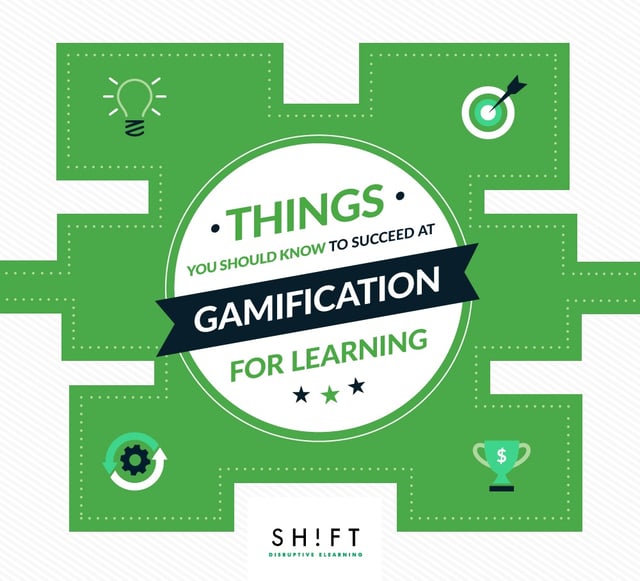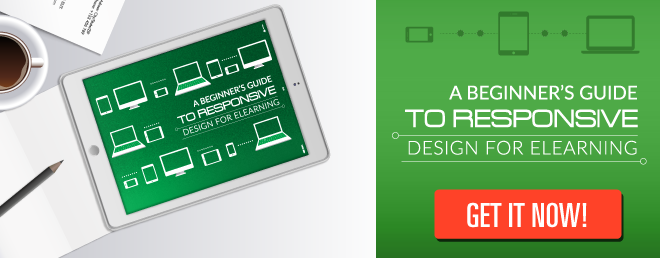Yes, gamification is BIG right now in the eLearning and training industries. Yes, it’s effective in engaging participants. Yes, everyone is doing it. However, this shouldn’t be the only reason to incorporate gamification into your HR programs.
In order to gamify eLearning courses successfully take these points into consideration before slapping on a point system and calling it a day:

1) Gamify with Purpose
While adding in gaming elements to a course can make it more fun, if you don’t have a definitive goal for what you want your students to accomplish, the course will likely get off track and not succeed in achieving that goal. This is partial because not having a purpose in mind will often make objectives muddled and confusing to players (aka learners). A confused player is a frustrated player, and a frustrated player is one who won’t learn from your course.
So, before you begin, ask yourself what is the purpose of gamification in this course? Do I simply want to increase the number of students who make it to the end? Do I want to improve grades or increase the amount of student interaction with each other? Or, all of the above?
Answering this question will make it infinitely easier to design your strategy and much, much easier to evaluate the success of the course. Overall, it will be far more important to focus on this goal rather than the specifics of how the game works (i.e. points, levels, etc.)
Once you have considered what the goal is, ask yourself if gamification will help you meet that goal? And will it be in line with your learners’ expectations and needs?
Gamification is very popular right now, but instead of just going by hype, consider these things when deciding whether or not to gamify:
- Will gamification contribute to the participant’s learning experience? Some types of content and topics are more likely to work in a gamified format.
- Is this strategy appropriate for my audience? In general, some type of audiences are going to be less inclined to want to learn in a gaming format.
- What is the timeframe and cost associated with creating the gamification elements?
Also read: Gamification in Corporate Learning – Is Gamification right for your organization?
2) Gamification ≠ Competition
Competition is an element of gamification, but it is not the goal of it. Ultimately, gamification is a tool that helps motivate learners and often makes retention of material easier. It inspires engagement and active participation, which make learning and retention better for learners who would normally just be passive observers. If you make the point of your course winning or being better than fellow learners, then this is all your students will focus on.
“Gamification of learning is about learning,” says Marcus Warn, Head of Global Learning and Development at Spotify. He goes on to say that his experience has taught him that if the prize is too big or outcome too important (such as huge monetary sums or promotion), then learners only focus on winning and not learning so you can’t let this be exclusively about completion. [1]
Read more here.
Don’t overlook things like positive reinforcement, feedback, and collaborative efforts, which will all, be important long after the competition is over. In fact, before you even attempt gamification you should always ask yourself if it is going to enhance or contribute to the learning process (Reread point 1). If you don’t know or are unsure, then you need to take a step back and figure out if it can help before attempting it.
When creating gamification elements for your corporate learning course keep these points in mind:
- Give your game meaning beyond just ranking or who can get done fastest.
- Build-in positive feedback to encourage learners to show their work.
- Always allow for more than one learner to be recognized for the same thing, so it isn’t just a competition to fill a top spot.
- Acknowledge when a learner does something right each time.
- Let employees set their own pace.
- Let employees opt out of the game. If they don’t want to play, it will just demotivate them.
- Value quality over quantity. If part of your gamification is to do something like share social media posts or write updates on a forum make sure it is not the just the quantity of these things a learner does. You don’t want to reward oversharing or spamming that is designed only to get to the top of the leaderboard. Find a way, instead, to qualify what is shared.
3) Gamification Should Provide Meaningful Rewards
To ensure that gamification is effective in sparking motivation, it must put the goals of learners ahead of things like points and badges and provide meaningful rewards that are in line with your learners’ needs and goals.
Continuous, real-time feedback is essential to ongoing motivation and provides a mini-reward along the way that appeals to the need for improvement. Erik Johnston associate professor at Arizona State University's School of Public Affairs says even negative feedback is more of a motivator than no feedback at all since it is important for people to feel that they are being paid attention to and that their actions have meaning. Continuous feedback puts the focus on the journey of learning and the process instead of merely getting to the end. [2]
Consider the pros and cons of these reward types when designing your gamification:
- Discounts and Monetary Incentives: The upside to offering cash and discounts is that people are easily interested by this kind of reward. The downside is that it inspires more loyalty to the savings than to the actual course or program meaning your learners will quite easily move on for a better deal or stop using your course if the incentives stop.
- Personal Recognition: If you allow your learners to do something like give points to forum posts that are most helpful you give people a sense that their ideas are being heard, and this will encourage them to participate and learn more. The downside is that some users could abuse this and find ways to artificially boost their own posts either through popularity, fake accounts or by only talking about topics they know will gain the most attention.
Read more about Why Points Achieve Behavioral Change
Getting Started with Gamification
Successful gamification of an eLearning course starts with thinking about the objectives and how you can turn information into a game-like activity.
- Identify the behavior you want your learners to gain or change to encourage it.
- Consider what gaming elements make sense for your course’s goals. Are your students more likely to be motivated by personal recognition or monetary rewards?
- Decide what rewards you should offer and how your learners will redeem. Setting the reward goal too low will make it seem as if it doesn’t mean anything to get it while setting the bar too high will lead to frustration.
Recommended reads:
- How Gamification Will Impact Corporate Learning
- Gamification for Corporate Training Infographic (Stats and Trends)
[1] Gamification mistakes. Lessons learned.https://www.linkedin.com/pulse/gamification-mistakes-lessons-learned-marcus-w%C3%A4rn?forceNoSplash=true
[2] Game on: could gamification help business change behaviour?https://www.theguardian.com/sustainable-business/game-on-gamification-business-change-behavior
[3] 8 Gamification of Learning Mistakes You Need to Avoid https://www.td.org/Publications/Blogs/Learning-Technologies-Blog/2014/12/8-Gamification-of-Learning-Mistakes-You-Need-to-Avoid
[4] Designing Gamification in the Right Way https://journals.ala.org/ltr/article/view/5632/6953
[5] Gamification in HR – Should You Try It? https://cultureiq.com/gamification-hr-try/



